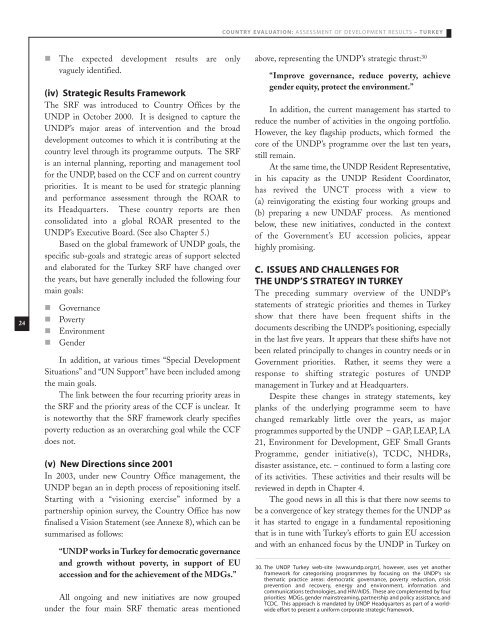Reports - United Nations Development Programme
Reports - United Nations Development Programme
Reports - United Nations Development Programme
You also want an ePaper? Increase the reach of your titles
YUMPU automatically turns print PDFs into web optimized ePapers that Google loves.
COUNTRY EVALUATION: ASSESSMENT OF DEVELOPMENT RESULTS – TURKEY<br />
24<br />
<br />
The expected development results are only<br />
vaguely identified.<br />
(iv) Strategic Results Framework<br />
The SRF was introduced to Country Offices by the<br />
UNDP in October 2000. It is designed to capture the<br />
UNDP’s major areas of intervention and the broad<br />
development outcomes to which it is contributing at the<br />
country level through its programme outputs. The SRF<br />
is an internal planning, reporting and management tool<br />
for the UNDP, based on the CCF and on current country<br />
priorities. It is meant to be used for strategic planning<br />
and performance assessment through the ROAR to<br />
its Headquarters. These country reports are then<br />
consolidated into a global ROAR presented to the<br />
UNDP’s Executive Board. (See also Chapter 5.)<br />
Based on the global framework of UNDP goals, the<br />
specific sub-goals and strategic areas of support selected<br />
and elaborated for the Turkey SRF have changed over<br />
the years, but have generally included the following four<br />
main goals:<br />
<br />
<br />
<br />
<br />
Governance<br />
Poverty<br />
Environment<br />
Gender<br />
In addition, at various times “Special <strong>Development</strong><br />
Situations” and “UN Support” have been included among<br />
the main goals.<br />
The link between the four recurring priority areas in<br />
the SRF and the priority areas of the CCF is unclear. It<br />
is noteworthy that the SRF framework clearly specifies<br />
poverty reduction as an overarching goal while the CCF<br />
does not.<br />
(v) New Directions since 2001<br />
In 2003, under new Country Office management, the<br />
UNDP began an in depth process of repositioning itself.<br />
Starting with a “visioning exercise” informed by a<br />
partnership opinion survey, the Country Office has now<br />
finalised a Vision Statement (see Annexe 8), which can be<br />
summarised as follows:<br />
“UNDP works in Turkey for democratic governance<br />
and growth without poverty, in support of EU<br />
accession and for the achievement of the MDGs.”<br />
All ongoing and new initiatives are now grouped<br />
under the four main SRF thematic areas mentioned<br />
above, representing the UNDP’s strategic thrust: 30<br />
“Improve governance, reduce poverty, achieve<br />
gender equity, protect the environment.”<br />
In addition, the current management has started to<br />
reduce the number of activities in the ongoing portfolio.<br />
However, the key flagship products, which formed the<br />
core of the UNDP’s programme over the last ten years,<br />
still remain.<br />
At the same time, the UNDP Resident Representative,<br />
in his capacity as the UNDP Resident Coordinator,<br />
has revived the UNCT process with a view to<br />
(a) reinvigorating the existing four working groups and<br />
(b) preparing a new UNDAF process. As mentioned<br />
below, these new initiatives, conducted in the context<br />
of the Government’s EU accession policies, appear<br />
highly promising.<br />
C. ISSUES AND CHALLENGES FOR<br />
THE UNDP’S STRATEGY IN TURKEY<br />
The preceding summary overview of the UNDP’s<br />
statements of strategic priorities and themes in Turkey<br />
show that there have been frequent shifts in the<br />
documents describing the UNDP’s positioning, especially<br />
in the last five years. It appears that these shifts have not<br />
been related principally to changes in country needs or in<br />
Government priorities. Rather, it seems they were a<br />
response to shifting strategic postures of UNDP<br />
management in Turkey and at Headquarters.<br />
Despite these changes in strategy statements, key<br />
planks of the underlying programme seem to have<br />
changed remarkably little over the years, as major<br />
programmes supported by the UNDP – GAP, LEAP, LA<br />
21, Environment for <strong>Development</strong>, GEF Small Grants<br />
<strong>Programme</strong>, gender initiative(s), TCDC, NHDRs,<br />
disaster assistance, etc. – continued to form a lasting core<br />
of its activities. These activities and their results will be<br />
reviewed in depth in Chapter 4.<br />
The good news in all this is that there now seems to<br />
be a convergence of key strategy themes for the UNDP as<br />
it has started to engage in a fundamental repositioning<br />
that is in tune with Turkey’s efforts to gain EU accession<br />
and with an enhanced focus by the UNDP in Turkey on<br />
————————————————————————————————————<br />
30. The UNDP Turkey web-site (www.undp.org.tr), however, uses yet another<br />
framework for categorising programmes by focusing on the UNDP’s six<br />
thematic practice areas: democratic governance, poverty reduction, crisis<br />
prevention and recovery, energy and environment, information and<br />
communications technologies, and HIV/AIDS. These are complemented by four<br />
priorities: MDGs, gender mainstreaming, partnership and policy assistance, and<br />
TCDC. This approach is mandated by UNDP Headquarters as part of a worldwide<br />
effort to present a uniform corporate strategic framework.

















